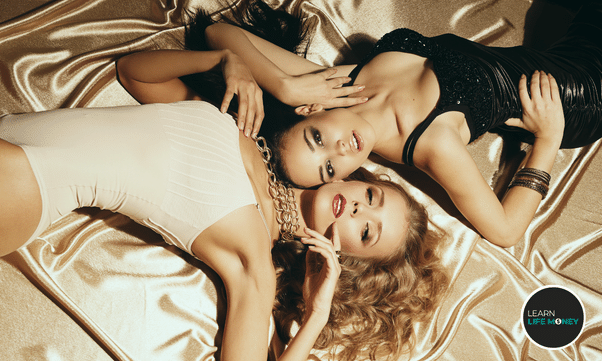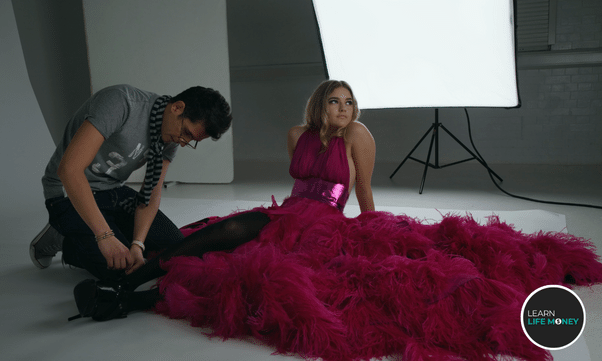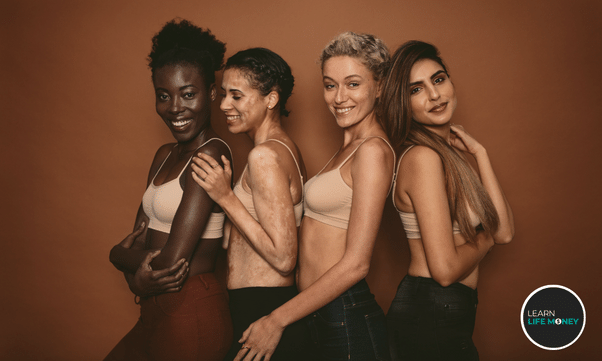How much should you charge as a Model?

People who dream of breaking into the modeling profession often ask how much they can earn as a model in the United States or what a fair hourly rate to charge.
The modeling industry is expansive, with various tiers of models.
Here’s what you should know: Starting out, freelance model rates in the United States can range from $20 to $50 per hour.
If you’re a pro, your hourly rate could be anywhere from $75 to $100, depending on your level of expertise.
Additionally, some models opt for a set day rate.
In this industry, some folks are raking in millions while others are grappling to make it work.
I’ll delve into the factors that can either make or break your modeling income in this blog.
For those of you aspiring to make it big in modeling but feeling a bit lost about the hourly rates in the US market, this article is your guiding light.
With your queries in mind, let’s shed light on the elements that influence model hourly earnings and what attributes set them apart to command those higher rates.
We’re talking standard rates, proposed rates, and pricing strategies. Now, let’s get into it!
What Is Modeling?

You know what, diving into the modeling industry is not as straightforward as it might seem.
It’s a multifaceted field with various dimensions to consider.
The path you choose shapes the type of model you’ll become, and naturally, this will have an impact on your hourly pay in the US market.
To simplify it further, a modeling job boils down to presenting yourself in the best possible light to showcase clothing and accessories.
However, there’s a lot more depth to this modeling career than meets the eye, which we’ll delve into in the upcoming sections.
How to Get into the Modeling Industry?
People enter the modeling industry in one of two ways.
The first is via a modeling agency, while the second is through freelance.
Modeling Agencies

The way this works is that a model seeks agency representation, essentially enlisting a modeling agency to facilitate job opportunities.
These agencies, like the Elite Model Management, carry binders adorned with images of other models under their wing.
Models are often categorized based on their appearance, and agencies tend to group those with similar looks together.
Usually, a client will reach out to the modeling agency, specifying a particular look they’re after. The agent, well-versed in their roster, will then present models who they believe fit the bill.
If the client falls for the model and they’re available, a collaboration is set in motion.
In return for their dedicated services, agency models share a percentage of their fees with the agency, establishing a partnership that fuels this dynamic industry.
Freelance Modeling

Freelance model is another option for models.
If you want to work as a freelancer, you are solely responsible for finding employment.
As a result, because clients are unlikely to come to you, you may have to work more to obtain work.
You’ll have to hunt for vacancies and castings and apply for them, which may include attending several auditions and yet not getting in.
Of course, the perk is that you keep the whole amount you’re paid since, hey, you’re not an agent.
Both experienced models and less experienced models can pursue this avenue.
A successful model can navigate the freelance world with finesse, ensuring fair pay for their efforts.
Who Earns More: Agency Models Or Freelance Models?

It’s a common question: which type of model tends to earn more – agency models or freelance models?
And studies and polls consistently show that agency models tend to have higher modeling pay rates compared to their freelance counterparts.
Now, it’s important to note that reaching a point where you can command good money does take some time.
But once you’ve reached that stage, the opportunities can become so abundant that it’s almost a challenge to keep track of them all.
At this time, models often lean on their agencies to manage the logistics on their behalf.
For an experienced model, the pay range typically falls between $75 and $100 per hour.
This means a model may pull in anywhere from $375 to $500 for just a few hours of studio work in a day.
However, if they’re affiliated with an agency, they’re required to allocate 20% of their compensation to the agent.
So, in this scenario, an agency model would need to allocate $144 to the agent.
Different Kinds Of Modeling And Their Average Salaries
We’ve got more modeling specialties to explore, and I’m here to break down some of the key ones and give you the scoop on what models typically earn in each!
Runway Models

Alright, let’s talk about strutting your stuff on the runway.
During special events, runway models get to rock some seriously high-end fashion.
Backstage, they’re pros at quick changes, even if it means donning some extravagant, revealing, or not-so-comfy outfits.
They don’t get much say in what they wear, but that’s all part of the gig.
Now, remember, in the world of modeling, it’s not about stealing the spotlight. It’s about showcasing the latest trends.
Still, a model’s got to have that powerful walk, stand tall and slim, and fit snugly into the designer’s sample-size outfits to snag more gigs.
Their workday usually stretches over several hours. Starting from hair and makeup through rehearsals and wrapping up with the show itself, which can be over in the blink of an eye – thirty minutes or less!
Now, let’s talk budgets.
Paychecks can range from a whopping $20,000 for top-tier models, depending on how big a name the designer is. While others receive no payment at all.
Budgets vary, that’s just how it goes in this industry.
And hey, when you’re on your own work, remember, travel costs are part of the deal, but some designers do cover transportation expenses.
Editorial Models

You’ve probably noticed that when you turn the pages of editorial spreads in magazines, they frequently tell a story about clothing or exhibit new fashion trends.
Now, let’s chat about modeling for editorial.
It’s a unique gig that calls for a different set of skills compared to strutting down the runway, and the compensation reflects that.
If you’re landing a paid work gig in this domain and you’re doing well, you could be looking at around $100 per hour.
Of course, if you’re just starting, your earnings might begin at a more modest $20 per hour.
And hey, some models might even take on a potential gig for free, all in the pursuit of building up their portfolio and climbing up the ranks.
These gigs can sometimes lead to full-day shoots, so be prepared for a bit of a marathon, but trust me, it’s all worth it in the end.
So, embrace the world of editorial modeling, and who knows, you might just find yourself gracing those glossy pages!
Catalog Models

Catalog models are the heart of fashion brand catalogs and websites.
They’re the ones showcasing those gorgeous gowns and demonstrating how they truly complement the human form.
These models often become familiar faces, especially with most clients, returning for fresh product launches.
It’s not uncommon for them to tackle shoots with hundreds of different looks in a single week.
When it comes to catalog modeling, it’s all about fitting into specific proportions, and a versatile, relatable look is usually the way to go.
If you’re a model with a striking or distinctive face, you might find a niche in this field.
On average, a catalog model pulls in around $5,000 per month.
Now, here’s the exciting part.
With dedication and a well-established portfolio, you could be looking at earning between $7,000 to $11,000 per month, especially for that coveted multiple-day shoot.
Commercials And Advertising Models

Even while this isn’t as popular as it once was, game shows may occasionally send out gorgeous modeling for commercials and advertising to hand out their rewards.
We can’t determine whether the gameshow model earns more money than the other.
They are most likely highly rewarded, although not as well as a TV program host, clearly.
Their job, however, may be brief, which means that their overall salary may be less than expected, but it gives a model more exposure.
Once huge businesses start noticing you, there’s a good possibility one of them will employ you shortly.
The pay rate can substantially rise for models involved in modeling for commercials and advertising.
Some even command a day rate that’s significantly higher than usual.
Modeling For Body Parts

Modeling for body parts, commonly known as parts modeling, is another lucrative option.
Parts models employ only a portion of the body rather than the complete body.
Hands, feet, legs, lips, eyes, hair, and even some body parts are frequently used.
Companies frequently cover more than one portion of their body for shoots, or they may focus just on the most enticing part.
It’s difficult to put a monetary value on a hand model as opposed to a foot model or an eye model.
It’s a specialized profession requiring long hours, physical discomfort, and a strong drive to succeed – as well as exceptional sensitivity to the role you’re playing.
So, if you’re considering trying this out with your own hair, you might just find it to be a rewarding venture.
Modeling For TV Ads

Famous models make between $2,000 and $5,000 per day for TV advertisements and $2,000 to $5,000 per day for print advertising, according to a well-known American business journal.
If you’re considering stepping into this world, building up your portfolio can be key to unlocking opportunities for higher-paying gigs.
A female parts model with excellent legs and feet may earn roughly $75,000 per year – and much more in New York City, where major advertising agencies are based.
When you’ve honed your craft and established a reputation, you’ll find clients willing to pay hourly rates that reflect your expertise.
Remember, the more experienced you become, the more you can command, often paying higher rates for your specialized skills.
Child Models

Child models can earn from $5 to $250 per hour.
The wage is determined by whether they are a child or a teenager, a novice or a seasoned model, and whether the organization pays daily or hourly.
With that, pricing can vary greatly depending on the type of modeling you pursue.
For instance, commercial gigs often have a different price tag than high-end fashion shoots.
Budget plays a role, too, as smaller, independent enterprises might have different resources than larger corporations.
It also depends on what kind of model you want to be.
Furthermore, as previously said, tiny, independent enterprises pay less than large corporations.
If you’re just starting out, you might also come across amateur photographers who are building their portfolios, and that’s perfectly okay.
They can offer valuable experience even if the pay is lower.
As you progress, you’ll likely start working with more established clients who have bigger budgets for their projects.
Factors That Define The Average Salary Of Models

Like any other profession, the typical wage of models is determined by various factors, the most obvious of which are attractiveness, experience, and portfolio.
This section will discuss other factors that influence model wages in the United States.
Work Market: Indie and small enterprises are likelier to pay less than large fashion houses with larger budgets.
Of course, this means you won’t be able to make as much at the start of your career!
Location: Working in one of the world’s fashion capitals, such as New York, Paris, and Milan, will likely pay you more than working in a lesser-known fashion city.
Gender: Male models earn less than female models on average because female models are in more demand.
This is one of the few sectors where women are likely to get paid more than males.
Working Hours: Depending on how effective you or your agency are at arranging reservations, you may work as little as one day per week or as many as seven days per week.
Appearance: This may not seem very lovely, but it is true that you may be considered worth more or less depending on how well you fit the required look and size.
Negotiation skills: You can earn a lot more money if you can negotiate a strong deal.
If you don’t negotiate at all, you can find yourself underpaid for your skills.
Sometimes, clients withhold models’ pay for work-related expenses.
Flights, taxis, vehicles, meals, housing, and other expenditures might all be included, especially when going to another city.
This requires travel but can ultimately be a worthwhile investment in your job.
Final Thoughts on How Much Should You Charge as a Model

Models are people, too, and they work in the same industry as photographers, both attempting to make a career doing what they enjoy.
As a result, agencies must be willing to pay a reasonable fee in return for their time.
It’s usually a good idea to pay more soon to develop a long-term working relationship with models.
Negotiating a proposed rate that works for both parties can be crucial, and this can often be handled on a case-by-case basis.
Furthermore, if a model is new to the profession, they may have to work for free to establish a portfolio and make business connections.
This will not only help them become acquainted with the work environment but also help them obtain a job in the future.
Starting out can be challenging, but taking on these initial challenges can lead to valuable experience and opportunities.
To summarize, how much you earn as a model is determined by the area you pursue and the level of competence you now possess.
Remember, commercial shoots often require travel, so considering travel costs and compensation for your services is important.
Building relationships with business companies and photographers can also be key to consistent work and potentially higher-than-average earnings in the long run.


















